Posts Tagged: features
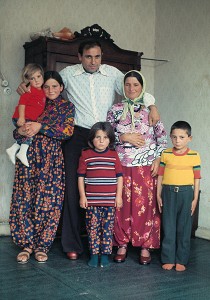
Candida Höfer’s Türken in Deutschland as “Counter-publicity”
By Amy A. DaPonte
Millions of Turkish immigrants settled in Germany after World War II to answer the call of politicians who needed to refresh the labor force after the war. Images of Turks at work or leisure in the parks, homes, markets, shops, and bars of 1970s West German cities populate Candida Höfer’s large, multiformat series entitled Türken in Deutschland (Turks in Germany, 1972–79).

Candida Höfer’s Türken in Deutschland as “Counter-publicity”
By Amy A. DaPonte
Millions of Turkish immigrants settled in Germany after World War II to answer the call of politicians who needed to refresh the labor force after the war. Images of Turks at work or leisure in the parks, homes, markets, shops, and bars of 1970s West German cities populate Candida Höfer’s large, multiformat series entitled Türken in Deutschland (Turks in Germany, 1972–79).
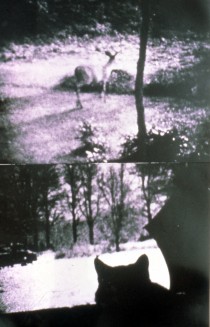
“The Cat Is My Medium”: Notes on the Writing and Art of Carolee Schneemann
By Thyrza Nichols Goodeve
For several years, Carolee Schneemann has presented an ever-evolving performative lecture about her work, starting with drawings she made at the ages of four and seven. I first saw it in 2009 at St. Mark’s Church.

“The Cat Is My Medium”: Notes on the Writing and Art of Carolee Schneemann
By Thyrza Nichols Goodeve
For several years, Carolee Schneemann has presented an ever-evolving performative lecture about her work, starting with drawings she made at the ages of four and seven. I first saw it in 2009 at St. Mark’s Church.

Dead Boars, Viruses, and Zombies: Roberto Jacoby’s Art History
By Daniel R. Quiles
The subtlest of deceptions lies in wait in a “1000 Words” feature on Roberto Jacoby in the March 2011 issue of Artforum.

Dead Boars, Viruses, and Zombies: Roberto Jacoby’s Art History
By Daniel R. Quiles
The subtlest of deceptions lies in wait in a “1000 Words” feature on Roberto Jacoby in the March 2011 issue of Artforum.
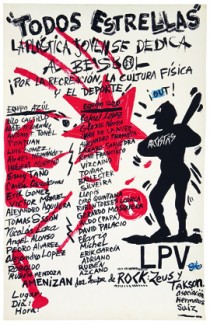
Nueve entradas en 1989
By Tamara Díaz Bringas
Playball, habría dicho el umpire para iniciar aquel partido de béisbol con tantos artistas y ningún pelotero. Playball, habrían oído los jugadores, sospechando tal vez que el juego había empezado en verdad mucho antes de aquel 24 de septiembre de 1989.

Nueve entradas en 1989
By Tamara Díaz Bringas
Playball, habría dicho el umpire para iniciar aquel partido de béisbol con tantos artistas y ningún pelotero. Playball, habrían oído los jugadores, sospechando tal vez que el juego había empezado en verdad mucho antes de aquel 24 de septiembre de 1989.
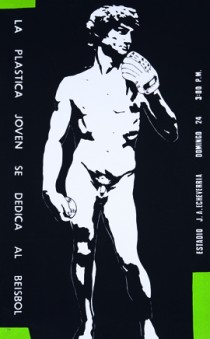
Nine Innings in 1989
By Tamara Díaz Bringas
“Play ball!” the umpire would have said to start that baseball game with so many artists and not a single ballplayer. “Play ball!” the players would have heard, perhaps suspecting that the game had really begun long before that 24th of September in 1989.

Nine Innings in 1989
By Tamara Díaz Bringas
“Play ball!” the umpire would have said to start that baseball game with so many artists and not a single ballplayer. “Play ball!” the players would have heard, perhaps suspecting that the game had really begun long before that 24th of September in 1989.
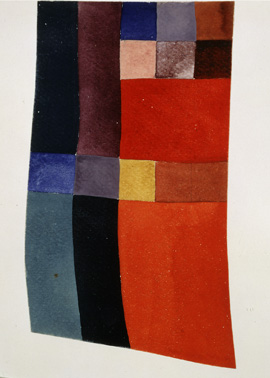
Dada Dance: Sophie Taeuber’s Visceral Abstraction
By Nell Andrew
In a recent landmark exhibition on the intersection of art and dance, Danser sa vie, the Centre Georges Pompidou displayed an enigmatic photograph identified as the artist Sophie Taeuber dancing at the Cabaret Voltaire in 1916. It is not uncommon for a photograph to stand in as an icon of a live event and offer what we hope is access to some present now passed, but for decades scholars have disagreed on the date and location of the Taeuber photograph.

Dada Dance: Sophie Taeuber’s Visceral Abstraction
By Nell Andrew
In a recent landmark exhibition on the intersection of art and dance, Danser sa vie, the Centre Georges Pompidou displayed an enigmatic photograph identified as the artist Sophie Taeuber dancing at the Cabaret Voltaire in 1916. It is not uncommon for a photograph to stand in as an icon of a live event and offer what we hope is access to some present now passed, but for decades scholars have disagreed on the date and location of the Taeuber photograph.
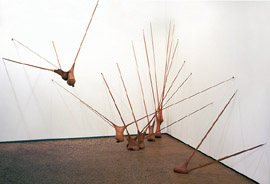
Sexing Sculpture: New Approaches to Theorizing the Object
By Jillian Hernandez and Susan Richmond
This forum, which originated as a panel at the 2013 Annual Conference of the College Art Association in New York, developed from the following question: how do sculptural practices uphold or, conversely, equivocate the certainties of gendered and sexual embodiment?

Sexing Sculpture: New Approaches to Theorizing the Object
By Jillian Hernandez and Susan Richmond
This forum, which originated as a panel at the 2013 Annual Conference of the College Art Association in New York, developed from the following question: how do sculptural practices uphold or, conversely, equivocate the certainties of gendered and sexual embodiment?

Queer Formalisms: Jennifer Doyle and David Getsy in Conversation
By Jennifer Doyle and David Getsy

“A Clear Day and No Memories”: Neurology, Philosophy, and Analogy in Kerry Tribe’s H.M.
By Matthew Goulish
In order to begin I must tell a horror story. I will try to mitigate the horror, through accuracy of telling, through facts, and through a degree of humility before them. Yet I will acknowledge it. I mean I already have. Horror is not fact.

“A Clear Day and No Memories”: Neurology, Philosophy, and Analogy in Kerry Tribe’s H.M.
By Matthew Goulish
In order to begin I must tell a horror story. I will try to mitigate the horror, through accuracy of telling, through facts, and through a degree of humility before them. Yet I will acknowledge it. I mean I already have. Horror is not fact.
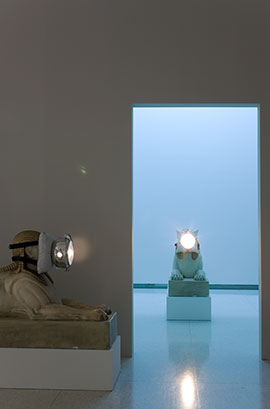
If It Need Be Termed Surrender: Trisha Donnelly’s Subjunctive Case
By Michael Jay McClure
Allow for a problem within contemporary art, a problem concerning emptiness. After experiencing and writing on installations that, say, immersed me in cave systems, faux-hospitals, or forests, after navigating landscapes of fur or video labyrinths, I found myself, often, elsewhere. A group of contemporary installations seemed overwhelmingly spare, a few small objects, and I began to wonder what such a shift of spatial tenancy meant.

If It Need Be Termed Surrender: Trisha Donnelly’s Subjunctive Case
By Michael Jay McClure
Allow for a problem within contemporary art, a problem concerning emptiness. After experiencing and writing on installations that, say, immersed me in cave systems, faux-hospitals, or forests, after navigating landscapes of fur or video labyrinths, I found myself, often, elsewhere. A group of contemporary installations seemed overwhelmingly spare, a few small objects, and I began to wonder what such a shift of spatial tenancy meant.
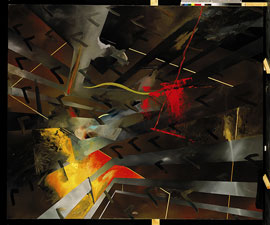
Richter’s Willkür
By Christine Mehring
Following on the heels of his signature photorealist blurs, Gerhard Richter’s abstract paintings have long exemplified a “permanent break in style as principle of style,” as Klaus Honnef noted in the artist’s first retrospective catalogue in 1969.

Richter’s Willkür
By Christine Mehring
Following on the heels of his signature photorealist blurs, Gerhard Richter’s abstract paintings have long exemplified a “permanent break in style as principle of style,” as Klaus Honnef noted in the artist’s first retrospective catalogue in 1969.

Zero at the Bone: Louise Fishman Speaks with Carrie Moyer
By Louise Fishman and Carrie Moyer
This all came to me in the last couple of weeks. In the late 1980s, early 1990s, my partner and I had gone to Madrid to see the big Velázquez retrospective. I’d never been to the Prado. I spent a lot of time looking at the Velázquez and wandering around the museum. Eventually I found Goya’s Black Paintings.

Zero at the Bone: Louise Fishman Speaks with Carrie Moyer
By Louise Fishman and Carrie Moyer
This all came to me in the last couple of weeks. In the late 1980s, early 1990s, my partner and I had gone to Madrid to see the big Velázquez retrospective. I’d never been to the Prado. I spent a lot of time looking at the Velázquez and wandering around the museum. Eventually I found Goya’s Black Paintings.

The Terms of Craft and Other Means of Making: Lee Bontecou’s Hybrid Trajectory
By Elyse Speaks
In 1958 Lee Bontecou began experimenting with a technique for making sculpture based on binding fabric to thin steel frames or armatures. Executed first on a small scale that oscillated between the form of the model and the form of tabletop sculpture, the works were emphatic in their distance from the shape and tenor of the dominant field of welded metal sculpture.

The Terms of Craft and Other Means of Making: Lee Bontecou’s Hybrid Trajectory
By Elyse Speaks
In 1958 Lee Bontecou began experimenting with a technique for making sculpture based on binding fabric to thin steel frames or armatures. Executed first on a small scale that oscillated between the form of the model and the form of tabletop sculpture, the works were emphatic in their distance from the shape and tenor of the dominant field of welded metal sculpture.

Shame: The One That Got Away
By Josephine Halvorson
The nineteenth-century painter Samuel Palmer lived within two hundred yards of the cemetery, making drawings, notes, and paintings in what he called the Valley of Visions in an effort to “bring up a mystic glimmer.” Sinclair, London Orbital Acid rain has eroded the words. Lichens, like Van Gogh blooms in orange and yellow, cling to the mauve stone.

Shame: The One That Got Away
By Josephine Halvorson
The nineteenth-century painter Samuel Palmer lived within two hundred yards of the cemetery, making drawings, notes, and paintings in what he called the Valley of Visions in an effort to “bring up a mystic glimmer.” Sinclair, London Orbital Acid rain has eroded the words. Lichens, like Van Gogh blooms in orange and yellow, cling to the mauve stone.
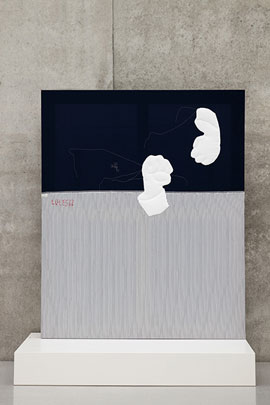
Ground Control: Painting in the Work of Cosima von Bonin
By Gregory H. Williams
During the past decade a steady flow of critical writing on contemporary painting has appeared, much of it seeking to define changes to the practice that have taken place since 1990. In several often-cited essays, a shared theme has emerged in which late-twentieth-century painting is described as undergoing a crisis of containment.

Ground Control: Painting in the Work of Cosima von Bonin
By Gregory H. Williams
During the past decade a steady flow of critical writing on contemporary painting has appeared, much of it seeking to define changes to the practice that have taken place since 1990. In several often-cited essays, a shared theme has emerged in which late-twentieth-century painting is described as undergoing a crisis of containment.

